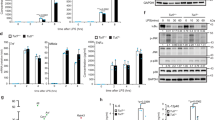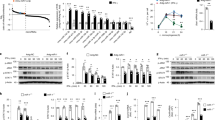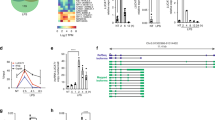Abstract
Mounting an effective host immune response without incurring inflammatory injury requires the precise regulation of cytokine expression1,2. To achieve this, cytokine mRNAs are post-transcriptionally regulated by diverse RNA-binding proteins and microRNAs (miRNAs) targeting their 3′ untranslated regions (UTRs)3,4. Zcchc11 (zinc-finger, CCHC domain-containing protein 11) contains RNA-interacting motifs5, and has been implicated in signalling pathways involved in cytokine expression6. The nature of the Zcchc11 protein and how it influences cytokine expression are unknown. Here we show that Zcchc11 directs cytokine expression by uridylating cytokine-targeting miRNAs. Zcchc11 is a ribonucleotidyltransferase with a preference for uridine and is essential for maintaining the poly(A) tail length and stability of transcripts for interleukin-6 (IL-6) and other specific cytokines. The miR-26 family of miRNAs targets IL-6, and the addition of terminal uridines to the miR-26 3′ end abrogates IL-6 repression. Whereas 78% of miR-26a sequences in control cells contained 1–3 uridines on their 3′ ends, less than 0.1% did so in Zcchc11-knockdown cells. Thus, Zcchc11 fine tunes IL-6 production by uridylating miR-26a, which we propose is an enzymatic modification of the terminal nucleotide sequence of mature miRNA as a means to regulate gene expression.
This is a preview of subscription content, access via your institution
Access options




Similar content being viewed by others
Accession codes
References
Nathan, C. Points of control in inflammation. Nature 420, 846–852 (2002).
Mizgerd, J. P. Acute lower respiratory tract infection. N. Engl. J. Med. 358, 716–727 (2008).
Jing, Q. et al. Involvement of microRNA in AU-rich element-mediated mRNA instability. Cell 120, 623–634 (2005).
Stoecklin, G. & Anderson, P. Posttranscriptional mechanisms regulating the inflammatory response. Adv. Immunol. 89, 1–37 (2006).
Aravind, L. & Koonin, E. V. DNA polymerase β-like nucleotidyltransferase superfamily: identification of three new families, classification and evolutionary history. Nucleic Acids Res. 27, 1609–1618 (1999).
Minoda, Y. et al. A novel Zinc finger protein, ZCCHC11, interacts with TIFA and modulates TLR signaling. Biochem. Biophys. Res. Commun. 344, 1023–1030 (2006).
Marchler-Bauer, A. et al. CDD: a conserved domain database for interactive domain family analysis. Nucleic Acids Res. 35, D237–240 (2007).
Laity, J. H., Lee, B. M. & Wright, P. E. Zinc finger proteins: new insights into structural and functional diversity. Curr. Opin. Struct. Biol. 11, 39–46 (2001).
Amarasinghe, G. K. et al. NMR structure of the HIV-1 nucleocapsid protein bound to stem-loop SL2 of the psi-RNA packaging signal. Implications for genome recognition. J. Mol. Biol. 301, 491–511 (2000).
Wang, L., Eckmann, C. R., Kadyk, L. C., Wickens, M. & Kimble, J. A regulatory cytoplasmic poly(A) polymerase in Caenorhabditis elegans. Nature 419, 312–316 (2002).
Saitoh, S. et al. Cid13 is a cytoplasmic poly(A) polymerase that regulates ribonucleotide reductase mRNA. Cell 109, 563–573 (2002).
Read, R. L., Martinho, R. G., Wang, S. W., Carr, A. M. & Norbury, C. J. Cytoplasmic poly(A) polymerases mediate cellular responses to S phase arrest. Proc. Natl Acad. Sci. USA 99, 12079–12084 (2002).
Martin, G. & Keller, W. Mutational analysis of mammalian poly(A) polymerase identifies a region for primer binding and catalytic domain, homologous to the family X polymerases, and to other nucleotidyltransferases. EMBO J. 15, 2593–2603 (1996).
Rissland, O. S., Mikulasova, A. & Norbury, C. J. Efficient RNA polyuridylation by noncanonical poly(A) polymerases. Mol Cell Biol 27, 3612–3624 (2007).
Kwak, J. E. & Wickens, M. A family of poly(U) polymerases. RNA 13, 860–867 (2007).
Meyer, S., Temme, C. & Wahle, E. Messenger RNA turnover in eukaryotes: pathways and enzymes. Crit. Rev. Biochem. Mol. Biol. 39, 197–216 (2004).
de Moor, C. H., Meijer, H. & Lissenden, S. Mechanisms of translational control by the 3′ UTR in development and differentiation. Semin. Cell Dev. Biol. 16, 49–58 (2005).
Salles, F. J., Richards, W. G. & Strickland, S. Assaying the polyadenylation state of mRNAs. Methods 17, 38–45 (1999).
Wu, L., Fan, J. & Belasco, J. G. MicroRNAs direct rapid deadenylation of mRNA. Proc. Natl Acad. Sci. USA 103, 4034–4039 (2006).
Behm-Ansmant, I. et al. mRNA degradation by miRNAs and GW182 requires both CCR4:NOT deadenylase and DCP1:DCP2 decapping complexes. Genes Dev. 20, 1885–1898 (2006).
Seitz, H., Ghildiyal, M. & Zamore, P. D. Argonaute loading improves the 5′ precision of both MicroRNAs and their miRNA strands in flies. Curr. Biol. 18, 147–151 (2008).
Morin, R. D. et al. Application of massively parallel sequencing to microRNA profiling and discovery in human embryonic stem cells. Genome Res. 18, 610–621 (2008).
Landgraf, P. et al. A mammalian microRNA expression atlas based on small RNA library sequencing. Cell 129, 1401–1414 (2007).
Katoh, T. et al. Selective stabilization of mammalian microRNAs by 3′ adenylation mediated by the cytoplasmic poly(A) polymerase GLD-2. Genes Dev. 23, 433–438 (2009).
Friedman, R. C., Farh, K. K., Burge, C. B. & Bartel, D. P. Most mammalian mRNAs are conserved targets of microRNAs. Genome Res. 19, 92–105 (2009).
Grimson, A. et al. MicroRNA targeting specificity in mammals: determinants beyond seed pairing. Mol. Cell 27, 91–105 (2007).
Lewis, B. P., Burge, C. B. & Bartel, D. P. Conserved seed pairing, often flanked by adenosines, indicates that thousands of human genes are microRNA targets. Cell 120, 15–20 (2005).
Nielsen, C. B. et al. Determinants of targeting by endogenous and exogenous microRNAs and siRNAs. RNA 13, 1894–1910 (2007).
Wu, H. et al. miRNA profiling of naive, effector and memory CD8 T cells. PLoS ONE 2, e1020 (2007).
Hutvagner, G., Simard, M. J., Mello, C. C. & Zamore, P. D. Sequence-specific inhibition of small RNA function. PLoS Biol. 2, E98 (2004).
Meister, G., Landthaler, M., Dorsett, Y. & Tuschl, T. Sequence-specific inhibition of microRNA- and siRNA-induced RNA silencing. RNA 10, 544–550 (2004).
Hua, Z. et al. MiRNA-directed regulation of VEGF and other angiogenic factors under hypoxia. PLoS ONE 1, e116 (2006).
Heil, F. et al. Species-specific recognition of single-stranded RNA via toll-like receptor 7 and 8. Science 303, 1526–1529 (2004).
Ruby, J. G. et al. Large-scale sequencing reveals 21U-RNAs and additional microRNAs and endogenous siRNAs in C. elegans. Cell 127, 1193–1207 (2006).
Ruby, J. G., Jan, C. H. & Bartel, D. P. Intronic microRNA precursors that bypass Drosha processing. Nature 448, 83–86 (2007).
Neilson, J. R., Zheng, G. X., Burge, C. B. & Sharp, P. A. Dynamic regulation of miRNA expression in ordered stages of cellular development. Genes Dev. 21, 578–589 (2007).
Shen, B. & Goodman, H. M. Uridine addition after microRNA-directed cleavage. Science 306, 997 (2004).
Cheng, A. M., Byrom, M. W., Shelton, J. & Ford, L. P. Antisense inhibition of human miRNAs and indications for an involvement of miRNA in cell growth and apoptosis. Nucleic Acids Res. 33, 1290–1297 (2005).
Lykke-Andersen, J. Identification of a human decapping complex associated with hUpf proteins in nonsense-mediated decay. Mol. Cell Biol. 22, 8114–8121 (2002).
Schmittgen, T. D. et al. Quantitative reverse transcription-polymerase chain reaction to study mRNA decay: comparison of endpoint and real-time methods. Anal. Biochem. 285, 194–204 (2000).
Acknowledgements
We thank P. Sharp for access to the Koch Institute bioinformatics core and C. Whittaker, R. Cook and A. Leshinsky for outstanding Illumina sequence collection and processing. Illumina analysis pipeline was supported by a National Cancer Institute PO1 grant (CA42063) to P.A.S. We thank K. Doud for technical assistance and I. Kramnik for help with the Luminex bead array. M.R.J. was supported by an American Physiological Society Fellowship in Physiological Genomics and a Parker B. Francis fellowship. L.J.Q. was supported by an American Lung Association Senior Research Training Fellowship and an NIH grant (K99 HL092956). J.R.N. was supported by an NIH grant (K99 CA131474). Studies were supported by NIH grants (R01 HL068153, R01 HL079392 and P01 ES00002).
Author information
Authors and Affiliations
Contributions
M.R.J. conceived this line of investigation and designed, performed and analysed most of the experiments. L.I.Q. and M.T.B. designed, performed and analysed some experiments and assisted with others. J.R.N. directed the deep sequencing study and helped interpret results. S.F. contributed to recombinant protein generation and functional assessment. A.R.I. performed proteomic experiments, identifying Zcchc11 in infected lungs. D.A.W. directed proteomic experiments and contributed to study design and interpretation. J.P.M. designed, analysed and directed the studies and guided the research programme. The manuscript was written by M.R.J., L.I.Q., M.T.B and J.P.M.
Corresponding author
Ethics declarations
Competing interests
The authors declare no competing financial interests.
Supplementary information
Supplementary Information
Supplementary Information (PDF 2443 kb)
Supplementary Information
Supplementary Table 1 (XLS 5755 kb)
Rights and permissions
About this article
Cite this article
Jones, M., Quinton, L., Blahna, M. et al. Zcchc11-dependent uridylation of microRNA directs cytokine expression. Nat Cell Biol 11, 1157–1163 (2009). https://doi.org/10.1038/ncb1931
Received:
Accepted:
Published:
Issue Date:
DOI: https://doi.org/10.1038/ncb1931
This article is cited by
-
TENT2, TUT4, and TUT7 selectively regulate miRNA sequence and abundance
Nature Communications (2022)
-
BCDIN3D RNA methyltransferase stimulates Aldolase C expression and glycolysis through let-7 microRNA in breast cancer cells
Oncogene (2021)
-
Terminal uridyltransferase 7 regulates TLR4-triggered inflammation by controlling Regnase-1 mRNA uridylation and degradation
Nature Communications (2021)
-
CDE-1 suppresses the production of risiRNA by coupling polyuridylation and degradation of rRNA
BMC Biology (2020)
-
Identification of oligo-adenylated small RNAs in the parasite Entamoeba and a potential role for small RNA control
BMC Genomics (2020)



